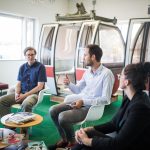Rare Diseases
By Joey Babbitt
The first thing to know about cancer is that “cancer” is not one disease. There are a hundred different forms of cancer caused by a multitude of biological processes that behave as uniquely as the individuals infected. For example, among lung cancer, you may have heard of small-cell or non-small-cell. Yet even among those two types, there’s adenocarcinoma, squamous cell, large cell, adenosquamous carcinoma, and sarcomatoid carcinoma. And as sequencing technology advances, we can characterize the gene mutations of the cancer’s molecular structure. So now it’s not just cancer or even lung cancer, but something a lot more complex like adenocarcinoma with a genetic alteration of the epidermal growth factor receptor (EGFR) gene. These complex distinctions among cancers, and even the mutations that occur from cell to cell within one patient’s cancer, is a major factor in trying to understand the disease and how it will respond to treatment.
Deep characterization of the tumor microenvironment like what we have seen in the age of next-generation sequencing (NGS), has enabled scientists to discover new biomarkers and pathways to treat cancer. Yet the track from discovery to viable treatment is a long and expensive one. It may seem obvious, but if it isn’t profitable for a company to create a drug for a rare cancer, then they may not choose to pursue it. Of course, this doesn’t mean that there aren’t options for patients with rare cancers, but the reality is that there is less funding, less research, less certainty, and more risks for these patients.
You may think, well if the cancer is rare, then it probably affects fewer people. But there are hundreds of cancers that affect hundreds to thousands of people, and in the end, even the rare cases add up to a large population. So although they are infrequently diagnosed in individuals, rare cancers affect millions of people! Something else to consider is that some cancers are rare because they only affect certain populations, such as children. In fact, all childhood cancers fulfill the definition of a rare disease.
One solution to incentivize companies to research treatments for rare cancer is to apply for their therapies to be designated as an orphan drug. It’s not just an adjective, it’s a term defined in the Orphan Drug Act (ODA) of 1983 that grants special status to a drug that intends to treat a disease with fewer than 200,000 reported cases. Orphan drugs go through the same rigorous process to prove their safety and effectiveness as any therapeutic, but the benefits of the status are financial in the form of tax credits, clinical trial subsidies, and market exclusivity. From 1983 to 2015, a total of 177 approvals originated from 1,391 orphan drug designations to treat rare cancers. A less statistical way to say this: millions of people finally had access to proven treatments.
Many of us in the biotech field are guilty of spending more time considering the probabilities, or thinking about samples, rather than remembering that each data point is a patient who we are trying to help. For the past several years, our employees at Cofactor have volunteered at Family House, an organization that provides housing, 100% free of charge, for families whose children are being treated for cancer and other life-threatening diseases at UCSF Benioff Children’s Hospital in San Francisco. Families travel from all over the country, often as a unit with their healthy children in tow, and Family House provides hospitality, sanctuary, nourishment, and a community to support those going through a difficult time. Cofactor employees cook dinner for the families and spend time getting to know them. Though we eventually have to go back to our benches to run samples, or back to the computer for analysis, it’s important to remind ourselves that beyond the economics of the business and beyond the complex biology, there are people fighting for their lives.





